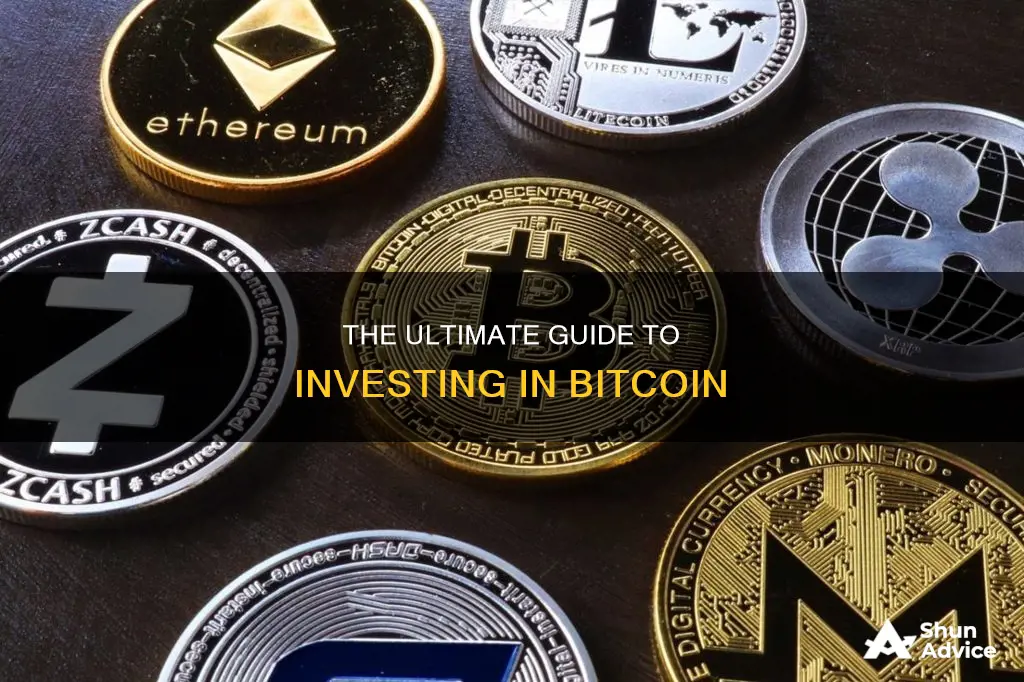
Bitcoin is a cryptocurrency that has become increasingly popular among investors in recent years. It was created to solve some of the flaws in the cryptocurrency market, such as the fraudulent duplication of coins. It uses blockchain technology, which disperses a single code over thousands of different computers, making it harder for hackers to access the code.
There are several ways to invest in Bitcoin, both directly and indirectly. You can purchase standalone Bitcoin from apps like Coinbase, which allow investors to take physical ownership of the asset. Alternatively, you can invest in a company that utilizes Bitcoin technology, such as exchange-traded funds (ETFs) that include shares from blockchain-related companies. Another option is to participate in Bitcoin mining, which involves allowing your computer to be used as a node for the public ledger, and miners are rewarded with Bitcoin for their contributions.
Before investing in Bitcoin, it is important to understand the risks involved. Bitcoin is a very high-risk and volatile investment, and its value may rise or fall dramatically in a short period. It is not backed by any physical asset or central regulator, and its value is dependent on market demand. Therefore, it is crucial to carefully consider your risk tolerance, investment strategy, and financial goals before investing in Bitcoin.
What You'll Learn

Choosing a Bitcoin exchange
- Objective: Before choosing an exchange, it's important to know what you want to achieve. For example, do you want to invest for the long term or trade in and out of positions regularly? If you want to invest for the long term, you might look to spot exchanges, which are platforms where you can buy and sell actual digital assets. If you want to trade regularly, you might be interested in derivatives—trading products such as futures and options based on the price action of underlying spot assets.
- Regulations and security: Different exchanges comply with different laws and regulations based on their locations, practices, and offerings. Some exchanges have Know Your Customer (KYC) and Anti-Money Laundering (AML) practices, which require participants to submit personal information. Many crypto exchanges ban customers from certain countries, so it's important to check that your country is supported. Security is also a key consideration—check to see if the exchange offers two-factor authentication (2FA) and what type of 2FA is compatible.
- Fiat compatibility: At some point, you will likely need a fiat-compatible exchange, which allows you to transfer national currencies (e.g. USD, CAD) into and out of the crypto world. Some exchanges have different fiat options, compatible with specific banks, so check that the exchange you choose supports your preferred fiat currency and bank.
- Volume and liquidity: Trading platforms vary based on the number of participants using them and the amount of each asset being traded. This is important because it affects how easily users can enter or exit positions. Check the order book on different exchanges to see what amounts of each asset are available, and how far the price levels are from one another. You can also check third-party websites like Coin360, CoinMarketCap, and OnChainFX for volume data.
- Supported coins and tokens: Virtually all crypto exchanges support Bitcoin and Ethereum, but there are thousands of cryptocurrencies, and some investors want exposure to other coins. Binance is a popular option because it grants traders and investors access to more cryptocurrencies than other platforms.
- Fees: Most exchanges charge a small fee for each trade, and these fees vary based on the platform. Fees may be more important for traders than for investors, as traders buy and sell more frequently. Some exchanges also have withdrawal fees and limits.
- User interface and user experience: This is very important for your success as a cryptocurrency trader or investor. An exchange with an intuitive interface and good user experience makes it easier to trade. However, user experience is subjective, so it's worth checking out several platforms and seeing which you find most accessible.
District Ox Coin: Worthy Investment or Ox-pensive Mistake?
You may want to see also

Getting a Bitcoin wallet
Once you've decided to invest in Bitcoin, you'll need to get a Bitcoin wallet to store your cryptocurrency. A crypto wallet is a place where you can securely keep your crypto. There are several types of crypto wallets, but the most popular ones are hosted wallets, non-custodial wallets, and hardware wallets.
Hosted Wallets
Hosted wallets are the most popular and easy-to-set-up type of crypto wallet. When you buy crypto using an app like Coinbase, your crypto is automatically held in a hosted wallet. It's called "hosted" because a third party keeps your crypto for you, similar to how a bank keeps your money in a checking or savings account. The main benefit of keeping your crypto in a hosted wallet is that if you forget your password, you won't lose your crypto. However, a drawback is that you can't access everything crypto has to offer.
To set up a hosted wallet, choose a platform you trust, create your account with a secure password, and buy or transfer crypto. Most crypto platforms and exchanges allow you to buy crypto using a bank account or credit card.
Non-Custodial Wallets
A self-custody wallet, like Coinbase Wallet, puts you in complete control of your crypto. Non-custodial wallets don't rely on a third party to keep your crypto safe. While they provide the software necessary to store your crypto, the responsibility of remembering and safeguarding your password falls entirely on you. If you lose or forget your password, there's no way to access your crypto.
To set up a non-custodial wallet, download a wallet app, create your account (no personal info is required), and write down your private key in a secure location. It's not always possible to buy crypto using traditional currencies with a non-custodial wallet, so you'll need to transfer crypto into your wallet from elsewhere.
Hardware Wallets
A hardware wallet is a physical device, about the thumb drive size, that stores the private keys to your crypto offline. Most people don't use hardware wallets because of their increased complexity and cost. However, they can keep your crypto secure even if your computer is hacked.
To set up a hardware wallet, buy the hardware (Ledger and Trezor are well-known brands), install the software from the official company website, and transfer crypto to your wallet.
Just as there are many ways to store cash, there are many ways to store crypto. You can keep things simple with a hosted wallet, have full control of your crypto with a non-custodial wallet, or take extra precautions with a hardware wallet.
Best Places to Invest Bitcoin in Canada
You may want to see also

Connecting your wallet to a bank account
Connecting your crypto wallet to a bank account is a straightforward process. Here is a step-by-step guide:
Choose a Reliable Platform
First, select a reputable cryptocurrency platform that supports the type of transfers you want to make, such as SEPA or SWIFT. Research user reviews, security features, and fees to ensure the platform is trustworthy. Some popular options include CryptoWallet, Coinbase, Crypto.com, and Binance.
Create an Account
Sign up and complete the necessary verification steps, such as KYC (Know Your Customer) checks and providing identification documents. This process may vary depending on the platform and your jurisdiction.
Transfer or Buy Crypto
Once your account is set up, you can transfer crypto from an external wallet or buy crypto using a bank account or credit card. This step may involve using the "Buy", "Deposit", or "Add" function on the platform.
Sell Crypto for Fiat Currency
After you have crypto in your account, you can sell it for fiat currency. Look for a "Sell" or "Trade" function on the platform. This step may involve selecting a trading pair, such as Bitcoin/USD or Bitcoin/EUR, and placing a sell order.
Add Bank Details
To withdraw your fiat currency, you will need to enter your bank account details. This may include your IBAN number for SEPA transfers or the SWIFT/BIC code for SWIFT transfers. Ensure that the information is accurate to avoid any issues.
Confirm the Transaction
Review the transaction details, including any fees, and confirm the transfer. The platform will then process your withdrawal request. The processing time can vary, from immediate to a few days, depending on the platform and the type of transfer.
Monitor Your Bank Account
Keep an eye on your bank account to ensure the funds arrive as expected. You should receive a notification from your bank once the transfer is complete.
It is important to note that transferring crypto to a bank account may come with certain fees and potential risks. Always research the platform and understand the process thoroughly before initiating any transactions. Additionally, the specific steps may vary slightly depending on the platform and your jurisdiction, so be sure to refer to the platform's instructions and guidelines.
A Beginner's Guide: Investing in Bitcoin Cash in the UK
You may want to see also

Placing your Bitcoin order
Once you have chosen a cryptocurrency exchange to use, you will need to establish an account and verify your identity. Before you can buy any crypto, you will need to fund your exchange account with another currency, such as US dollars.
Different types of orders allow traders to buy or sell a cryptocurrency with a lot of flexibility. A market order will execute immediately at the best available current market price and is considered the simplest and most basic type of crypto order. However, market orders cannot be cancelled because they are filled immediately and may be partially filled at several prices.
A stop order lets you specify the price at which the order should execute. If it falls to that price, your order will trigger a sell. Stop orders are usually set to minimize losses if the price of an asset drops considerably.
A limit order lets you set a minimum price for the order to execute—it will only execute at this price or higher. Limit orders are only fulfilled if the designated price is reached, and even then, execution is not guaranteed.
A stop-limit order is a combination of a stop order and a limit order, and it's used to minimize risk. A stop-limit order will buy or sell the cryptocurrency once the stop price is reached, and the trading activity continues until the whole order is filled.
After you have placed your buy order for your chosen cryptocurrency, you will need to store your cryptocurrency in a digital wallet. This can be hosted either by the cryptocurrency exchange or an independent wallet provider.
Investing $1000 in Bitcoin: Is it a Smart Move?
You may want to see also

Managing your Bitcoin investments
- Understanding the Risks: Before investing in Bitcoin, it is crucial to recognize the inherent risks associated with this volatile asset class. Conduct thorough research to grasp the potential impact of market volatility, regulatory changes, and other factors on your investments.
- Diversification: While Bitcoin can offer portfolio diversification due to its low correlation with traditional assets, it is essential to diversify your crypto holdings as well. Consider investing in other established cryptocurrencies like Ethereum or exploring the potential of decentralized finance (DeFi) and non-fungible tokens (NFTs).
- Long-Term Investment Strategy: Bitcoin's value has historically increased over time, despite short-term fluctuations. Adopting a long-term investment horizon can help you navigate the ups and downs of the market and potentially reap the benefits of long-term growth.
- Dollar-Cost Averaging (DCA): This strategy involves investing a fixed amount in Bitcoin at regular intervals, regardless of the price. By investing consistently, you can smooth out the impact of volatility and benefit from buying more when prices are low and less when prices are high.
- Security and Storage: Securely storing your Bitcoin is paramount. Consider using a combination of hot wallets (online wallets provided by exchanges or third-party software providers) and cold wallets (offline hardware devices). Ensure your hot wallet provider is insured and well-regulated, and always safeguard your private keys and passwords.
- Regular Monitoring and Adaptation: Stay updated with market trends, regulatory changes, and global economic events that can influence cryptocurrency prices. Regularly review your investment strategy and make adjustments as necessary to align with your financial goals and risk tolerance.
- Tax Implications: Remember that investing in Bitcoin and other cryptocurrencies can have tax implications. Familiarize yourself with the tax laws and regulations in your jurisdiction to ensure compliance and avoid unexpected tax liabilities.
- Emotional Discipline: Investing in Bitcoin can be an emotional rollercoaster due to its volatile nature. It is crucial to make investment decisions based on research and analysis rather than impulsive reactions to market movements.
- Limit Risk Exposure: As a general rule of thumb, consider limiting your exposure to risky assets like Bitcoin to a smaller portion of your overall investment portfolio. The recommended allocation varies, but it is generally advised not to invest more than you are comfortable losing.
- Stay Informed: The cryptocurrency market is rapidly evolving, with new innovations and developments occurring frequently. Stay informed about the latest trends, technological advancements, and industry news to make more informed investment decisions.
Which Nations Embrace Bitcoin?
You may want to see also
Frequently asked questions
Bitcoin is a type of cryptocurrency that was created in 2009 by a programmer or group of programmers using the name "Satoshi Nakamoto". It is a virtual currency that is secured through one-way cryptography and appears on a distributed ledger called a blockchain.
You can buy Bitcoin through a cryptocurrency exchange such as Coinbase, Binance, Kraken, Gemini, or Bitfinex. You will need to create an account, verify your identity, and link your bank account to get started.
A Bitcoin wallet is where you store your cryptocurrency. There are two types of wallets: a "hot wallet", which is operated by a cryptocurrency exchange or provider, and a "cold wallet", which is a physical piece of hardware similar to a flash drive.
This depends on your risk tolerance and investment strategy. Bitcoin is a very high-risk and volatile asset, so it is important to carefully consider how much you are comfortable investing. You can purchase fractions of a single coin, with some exchanges allowing investments as low as $25.







